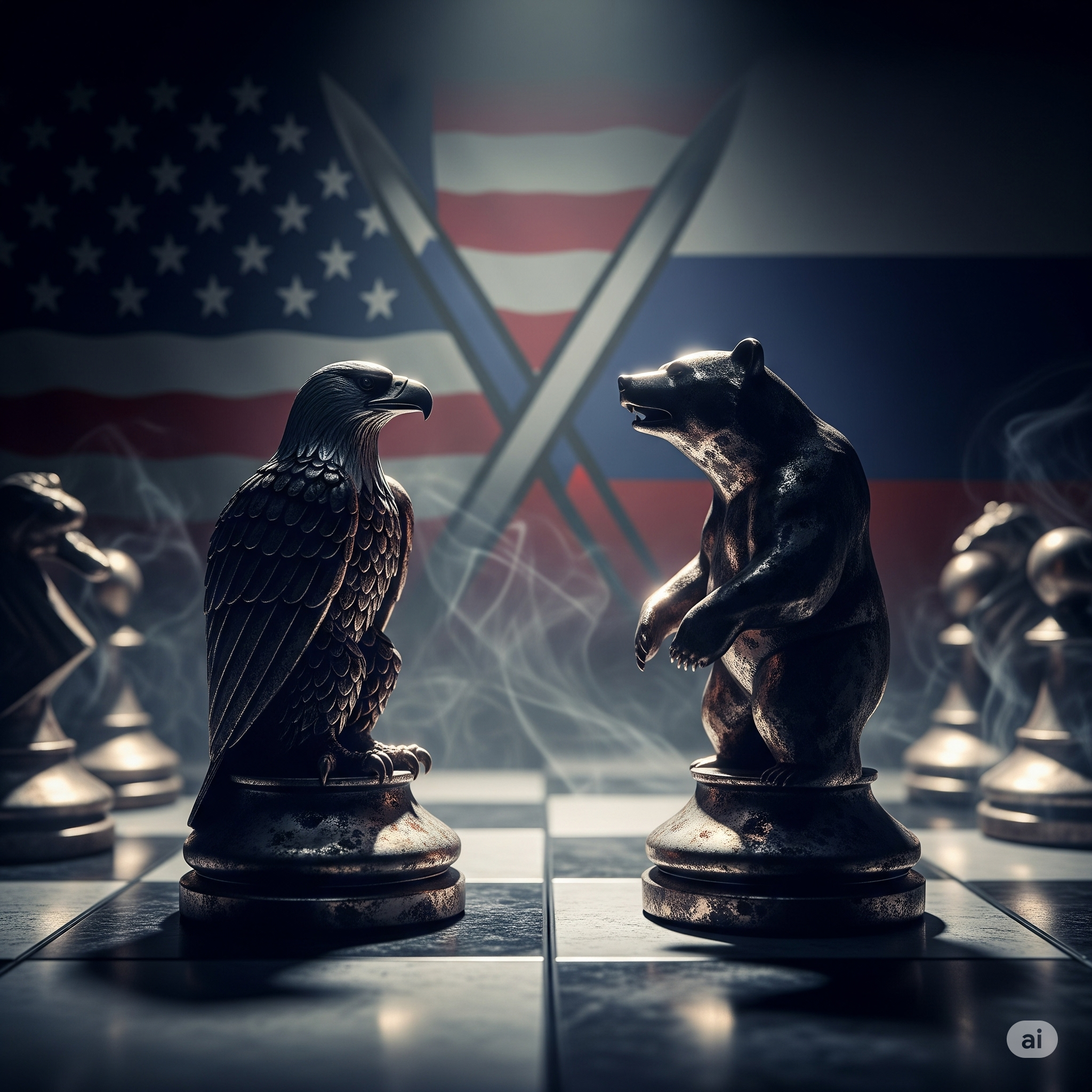Introduction
The relationship between the United States and Russia has been one of the most consequential and complex in modern global history. From the post-World War II era to the present day, U.S.-Russia relations have shaped international politics, security dynamics, economic policies, and ideological confrontations worldwide. This relationship, often referred to as the Cold War rivalry, was defined by ideological opposition, nuclear arms competition, geopolitical maneuvering, and mutual suspicion.
This article examines the historical background of the Cold War, differing perspectives of the U.S. and Russia (formerly the Soviet Union), key events, ongoing conflicts, and possible future scenarios. Understanding this relationship is essential for students of international relations, political science, and global history.
1. Origins of the U.S.-Russia Cold War
1.1 Post-World War II Context
- After World War II, the Soviet Union emerged as a superpower alongside the United States.
- Both nations had differing ideologies: capitalism and democracy in the U.S. versus communism and a one-party state in the USSR.
- Europe became the primary arena for post-war influence, with the Marshall Plan and the spread of Soviet influence in Eastern Europe creating tensions.
1.2 Ideological Confrontation
- The U.S. promoted liberal democracy, market economies, and political freedoms globally.
- The USSR sought to expand socialism and establish pro-Soviet regimes in Eastern Europe, leading to a clash of global ideologies.
- Mutual suspicion arose from ideological differences, security concerns, and competing visions of global order.
1.3 Early Flashpoints
- The division of Germany and Berlin, particularly the Berlin Blockade (1948-49), highlighted emerging tensions.
- The establishment of NATO (1949) and the Warsaw Pact (1955) formalized military alliances.
- The arms race, including the development of nuclear weapons, became a central feature of this rivalry.
2. Different Perspectives
2.1 U.S. Perspective
- The United States viewed the USSR as a threat to democracy, capitalism, and global stability.
- Policies like containment, outlined by George Kennan, aimed to limit Soviet influence and prevent the spread of communism.
- Key U.S. actions included involvement in Korean and Vietnam Wars, supporting anti-communist regimes, and maintaining nuclear superiority.
2.2 Soviet/Russian Perspective
- The USSR perceived the U.S. as attempting to encircle and weaken socialism.
- The U.S.’s military presence in Europe and global alliances were seen as direct threats to Soviet security.
- Soviet strategies focused on spreading socialism, strengthening satellite states, and achieving strategic parity in nuclear arms.
3. Key Events of the Cold War
3.1 Cuban Missile Crisis (1962)
- One of the closest moments to nuclear war.
- The USSR deployed missiles in Cuba; the U.S. demanded removal, resulting in tense negotiations.
3.2 Space Race
- Both nations competed for dominance in space exploration, culminating in the Apollo moon landing (1969) and Soviet space achievements.
3.3 Arms Race and Nuclear Deterrence
- Development of Intercontinental Ballistic Missiles (ICBMs) and nuclear arsenals defined global security.
- Policies like Mutually Assured Destruction (MAD) shaped military strategy.
3.4 Proxy Wars
- Conflicts in Korea, Vietnam, Afghanistan, and Latin America were influenced by U.S.-Soviet rivalry.
- These wars were indirect confrontations reflecting broader geopolitical interests.
3.5 Détente and Strategic Arms Limitation
- In the 1970s, both nations sought detente to reduce tensions.
- Treaties such as SALT I and II attempted to limit nuclear arms, though mutual distrust persisted.
4. End of the Cold War
4.1 Collapse of the Soviet Union (1991)
- Internal economic stagnation, political reforms, and nationalism led to the USSR’s dissolution.
- The U.S. emerged as the sole global superpower, leading to a period of unipolarity.
4.2 Post-Cold War Relations
- Initial cooperation included nuclear disarmament treaties and economic assistance to Russia.
- NATO expansion eastward created friction, as Russia perceived this as encroachment.
- Conflicts in the Balkans, Georgia, and Ukraine further strained relations.
5. Post-Cold War Tensions and Conflicts
5.1 NATO Expansion and Russian Concerns
- NATO admitted former Warsaw Pact nations, creating security concerns for Russia.
- U.S. support for Ukraine and Georgia intensified Russian fears of encirclement.
5.2 Cybersecurity and Hybrid Warfare
- In recent years, Russia has been accused of interfering in U.S. elections, cyber-attacks, and disinformation campaigns.
- These modern tactics reflect a shift from direct military confrontation to digital and political influence.
5.3 Economic Sanctions and Energy Politics
- U.S. and Western sanctions on Russia after Ukraine annexation in 2014 impacted the Russian economy.
- Energy trade, particularly gas and oil pipelines, became tools of geopolitical influence.
5.4 Military Confrontations and Proxy Conflicts
- Conflicts in Syria, Ukraine, and Eastern Europe illustrate ongoing strategic competition.
- Both nations maintain substantial nuclear arsenals, emphasizing deterrence over direct war.
6. Current State of U.S.-Russia Relations
- Relations remain tense due to geopolitical competition, military deployments, and ideological differences.
- Dialogue occurs intermittently, focusing on arms control, counter-terrorism, and global security issues.
- Russia seeks to assert itself as a global power, while the U.S. maintains strategic alliances with NATO and other partners.
7. Perspectives on the Future
7.1 Possible Scenarios
- Continued Rivalry – Relations may remain adversarial, with proxy conflicts, cyber warfare, and economic sanctions dominating interactions.
- Selective Cooperation – Collaboration on areas like arms control, climate change, and counter-terrorism could stabilize relations.
- Escalation Risks – Miscalculations, regional conflicts, or nuclear threats could provoke heightened tensions.
7.2 Emerging Global Context
- The rise of China as a global power introduces a triangular dynamic, influencing U.S.-Russia interactions.
- Economic interdependence and global challenges like climate change may push both nations toward pragmatic cooperation.
8. Lessons from U.S.-Russia Relations
- Ideology vs. Pragmatism – Ideological differences drive conflicts, but pragmatic engagement can prevent escalation.
- Arms Control Matters – Treaties and negotiations reduce the risk of catastrophic conflict.
- Global Perception and Trust – Maintaining credibility and trust is vital for international influence.
- Technological and Military Superiority – Continuous investment in innovation and defense strengthens negotiating power.
9. Conclusion
U.S.-Russia relations are shaped by a combination of historical rivalry, ideological differences, geopolitical competition, and strategic interests. While the Cold War officially ended with the collapse of the Soviet Union, the underlying dynamics of suspicion, power projection, and influence continue to influence global politics.
For students of international relations, understanding this relationship highlights how history, ideology, military strategy, economics, and diplomacy intersect to shape global order. The future of U.S.-Russia relations may involve cautious engagement, competition, and strategic balancing, making it one of the most critical areas of study in contemporary geopolitics.




